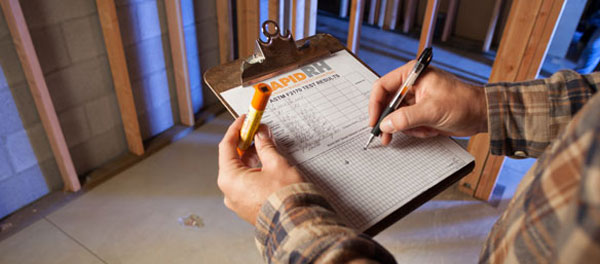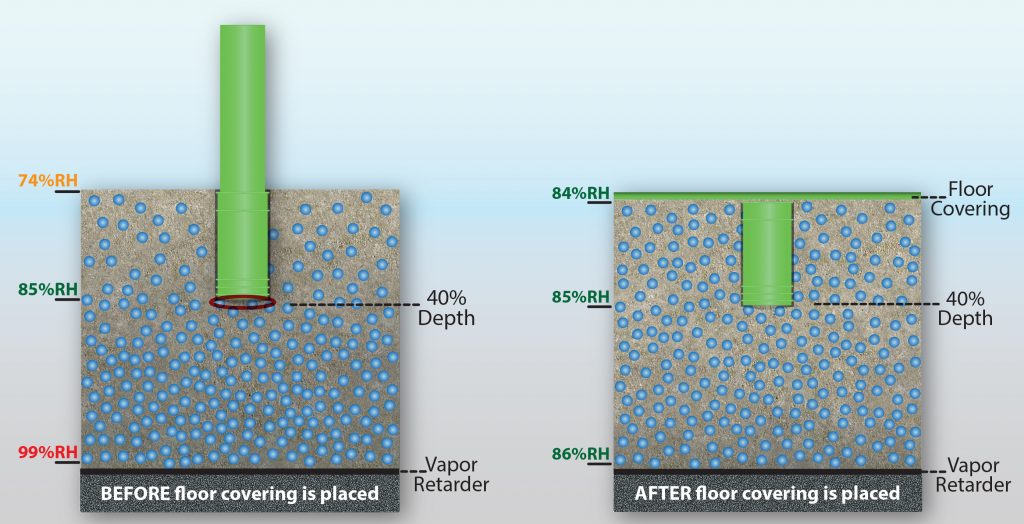Don’t Guess – Know the Concrete Moisture Level Before Work Starts

Written by Wagner Meters, first published in a shorter version by Building Services Management (Feb. 2015 issue)
Why wood flooring installers have to know how to measure moisture in concrete – yes, concrete.
What do you, the wood flooring installer, need to know about concrete? A lot, actually, if you want your installation to stay put without buckling, cupping or falling victim to other moisture-related wood flooring problems.
Concrete holds a lot of moisture. Wood flooring can absorb excess concrete moisture if it’s installed too early on top of the concrete. Therefore, even if you know nothing else about concrete, as a wood flooring installer, you at least need to know how concrete dries and when it’s dry enough for your work.
Traditionally, people have boiled down the time needed to dry concrete to one simple rule of thumb: one month of drying time for every one inch of slab thickness, once conditions are conducive for drying. Sounds easy enough, right? That’s the problem. This “one size fits all” rule is only meant as a guideline.
What flooring project is totally simple and straightforward? How many variables must be managed to get a beautiful, long-lasting floor into a home or building? Why would anyone be 100 percent confident that a simple rule of thumb gives them the information they need before installing the wood flooring?
How bad could it be?
Bad. The needed drying time has a direct impact on timelines and budgets, as well as the quality of the final result. Much has already happened by the time you, the wood flooring installer, arrive on the scene. This doesn’t mean you can’t exercise considerable control over when your work begins. If you install the floor too soon over a concrete slab that’s not sufficiently dry, it’s your wood flooring that shows the obvious, ugly, and potentially dangerous results. For the sake of your reputation and business, you need to know the slab’s moisture level before beginning your installation. No guessing. No relying on outdated, simplistic rules. You need real, quantifiable, actual measurements.
Does this scenario sound familiar?
The project schedule says that the wood flooring should be installed six months after a six-inch concrete slab has been laid down. That’s what the rule says to do. However, the general contractor (GC) runs a calcium chloride test just to double check. The test results show a moisture vapor emission rate (MVER) of three pounds. According to the flooring manufacturer’s specs, that’s within the wood flooring’s moisture tolerance. So, officially, the numbers indicate the wood flooring can be installed.
 Unfortunately, the installer is called back within six months having to answer questions about why his wood flooring is warping so badly that it is now considered a hazard. Perhaps the finish is even blistering or showing discoloration.
Unfortunately, the installer is called back within six months having to answer questions about why his wood flooring is warping so badly that it is now considered a hazard. Perhaps the finish is even blistering or showing discoloration.
The point is, both the GC and the wood flooring installer thought they had acted prudently and taken the necessary precautions to avoid this type of scenario. Instead, everyone is left figuring out who is to blame, who is liable legally and financially, and how it will be fixed.
This scenario is all too common. The costs associated with moisture-related flooring failures run into the millions of dollars each and every year. The pity of it all is that these problems can be prevented if people know the true concrete moisture level, instead of relying on guesses or test methods that are not scientifically proven as being reliable.
What factors affect concrete drying times?
A number of variables impact how long a specific slab of concrete needs to dry. Most aren’t within the wood flooring installer’s control. Still, it’s important to understand them in order to stay on top of what the installer can control.
Some of the critical factors affecting concrete drying time are:
- types of aggregate used in the concrete
- ratio of water to aggregate used in the concrete mix
- the slab’s thickness
- whether a vapor retarder or barrier was installed underneath the slab
- the quality of drainage around the slab
- temperature and humidity at the site
The reasons should be clear. More water in the slab from the start plus fewer options for moisture to escape all increase the likelihood that the slab will need a longer drying time than expected.
Other factors that impact drying may be more within the installer’s control, or at least within his ability to influence the GC with his opinion. These are:
- getting the environment enclosed and HVAC up and running in a timely manner
- movement of air across the slab’s surface
- use of dehumidifying equipment to speed up the drying process
As with wood, concrete’s moisture level is related to the ambient conditions surrounding it. If the humidity in the air is higher than in the concrete, the slab will absorb moisture; lower, and the slab will release moisture. Good air flow moves the evaporated moisture away before it has a chance to be re-absorbed when conditions change.
The use of dehumidifying equipment is intended to speed up the natural drying process. It’s easy to see why this may be an attractive option. Anything that can shorten construction timelines, or at least ensure they’re met, is good for the budget and makes for a happy client. However, use of this equipment still won’t tell you when the slab is sufficiently dry for the installation of the wood flooring.
The measurement that matters
The key piece of information you need to know before starting your installation work is the slab’s point of moisture equilibrium.
A concrete slab is never without moisture. Once flooring and finishes are put on top of it, the opportunity for moisture to evaporate is largely lost. Prior to the flooring installation, water content is lower at the slab’s surface due to evaporation. After installation, the slab’s remaining moisture will begin to spread out evenly and eventually reach the point of moisture equilibrium.

Here’s why it’s so important
The point of equilibrium signifies the moisture level that the flooring will “see” for the long term. If it’s too high, there’s a good chance the installer will get called back several months later to explain why the floor is warping.
To understand this better, it’s helpful to know what’s happening to the moisture within the slab as it is drying.
After the concrete slab has been poured, its moisture typically has only one escape route assuming it’s been poured over a vapor retarder. The moisture moves upward through the slab and evaporates at the surface. This is why leaving the slab’s surface uncovered is so critical to the drying process. It’s also why many people have assumed it makes sense to measure the amount of moisture evaporating at the surface as is done with the calcium chloride test. The problem is that the surface is exactly the wrong place to get an accurate reading of how dry a slab of concrete really is.
With up and out as moisture’s primary escape route, the slab’s internal moisture moves upwards through the concrete’s capillaries. The result of this moisture flow is that it creates a moisture gradient in which the surface tends to be drier than deeper within the slab. Any test that measures slab surface moisture won’t provide a complete picture of exactly how much moisture really exists within the slab.
Another factor contributes to the inherent unreliability of surface moisture measurements – don’t forget about air humidity. As noted earlier, when the air’s humidity is higher than the concrete slab, the concrete will absorb moisture. Where? Through its surface, which can temporarily boost moisture readings if a surface test is done at just the wrong time.
Similarly, when air humidity is low, moisture readings taken at the surface will indicate that the slab’s moisture content is lower than it really is. This can give you false security that the slab has dried sufficiently. The take-home lesson: If you want a true, reliable indication of the slab’s moisture condition, avoid taking your measurements at the slab’s surface.
Getting it just right
Nearly 20 years of scientific study show that the relative humidity within the concrete slab is indicative of the slab’s point of moisture equilibration once the finished floor is installed. More specifically, the relative humidity measured at 40 percent depth within the slab (assuming a slab is drying from one side only) provides this indispensable piece of information.
Taking the measurement at this precise depth and not on the concrete’s surface is the critical difference that makes a relative humidity (RH) test valuable and actionable, and surface moisture tests inherently unreliable.
What does this information mean for the wood flooring installer?
It means you should measure the concrete’s moisture content utilizing a RH test with probes or sensors placed into the slab at the critical 40 percent mark. RH probes provide the relative humidity as a percentage. You can then compare this number to the flooring manufacturer’s specifications.
Armed with the manufacturer’s RH specs and the slab’s RH percentage as provided by an RH test, you can now make an informed, confident decision as to whether the concrete is dry enough to hold and preserve your wood floor. No more guessing.